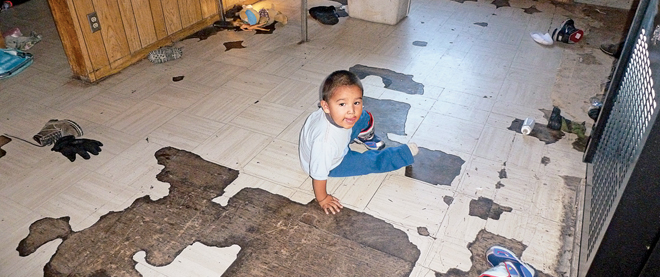Amid an emergency in Attawapiskat—a strategy
WELLS: Short attention spans will get the focus off Attawapiskat. Fixing the actual problem will take longer.
Oakland Ross/Toronto Star
Share

The Prime Minister’s Office distributes a daily “media barometer” that lists the stories getting the widest coverage and generating the most buzz on blogs and talk radio. Last week the public relations crisis at Attawapiskat First Nation entered its second week. The humanitarian crisis has been going on for longer. For the first time since the Harper government was elected in 2006, a story on Aboriginal affairs made it to the top of the PMO barometer.
Standard PMO procedure is to do what it takes to get a story off the top of the barometer. That’ll be easy enough for news of the appalling living conditions at Attawapiskat. Short attention spans will do the job without any help from the Langevin Block. Fixing the actual problem will take longer.
On Nov. 29, Aboriginal Affairs Minister John Duncan met until 10 p.m. with the cabinet subcommittee in charge of the strategic and operating review. He had prepared for his appearance for days. Every minister has to go through this. Their task is to explain how they will cut 10 per cent of their department’s spending, if needed.
If Duncan did not tell his colleagues, “You have got to be kidding,” he should be congratulated for his restraint.
In 1996, as Scott Serson, a former deputy minister of Indian affairs, wrote last week, “Annual growth in federal transfers to First Nation governments for basic services, such as primary and secondary education, social welfare and child and family services, was capped at an arbitrary two per cent per year as a deficit-fighting measure.”
The deficit was gone from 1998 to 2008. The two per cent cap never left. Aboriginal populations grow much faster than two per cent. To pay for education, health and—yes—welfare in communities where there are few stable jobs, governments have had to rob from other budgets, like housing. By one analysis I’ve seen, real per capita transfers from Ottawa to the provinces for health and social programs are up 40 per cent since 1996, while federal payments for reserve infrastructure are down 40 per cent over the same period. Housing was no good to begin with. The need has grown and the budgets have shrunk.
Sheila Fraser’s last report as auditor general, in June, said the problems go much deeper still. No federal government has ever clearly defined the services it should provide in First Nations communities or the desired outcomes. Services aren’t written into law and supported with multi-year budgets; they’re an endless series of one-offs. This allows governments to make announcements all the time, but it doesn’t allow communities to plan. “It is not certain whether funding levels provided to First Nations in one year will be available the following year,” Fraser wrote. Communities often reallocate money for months after they should have known whether core services would get this year’s funding.
Assume what we know to be untrue: that every band council in the country is full of goodwill and free of corruption. Not even angels could make progress when budgets do not keep pace with need and chaos is built into the system.
None of this is new. What’s new is that Stephen Harper seems to be taking steps to do something about it all.
Three recent news items hint at a government strategy on First Nations. Harper’s refusal to call it a strategy makes me even more sure it is one. Harper, who has not met with the premiers in more than three years, will meet with Aboriginal leaders in January in Ottawa. The PMO and the Assembly of First Nations have been working toward the meeting at least since June, and intensive preparatory work began nearly two months ago, before Attawapiskat made headlines.
The Prime Minister will be outnumbered 200 to one at this meeting. Opening and closing sessions will be televised. The whole thing is so out of character for Harper that it must be his idea. Nobody else could force him into it. What does he want out of the meeting? The announcement mentions “increased social and economic participation in Canadian society and improved living conditions in First Nations communities.” Details will have to wait. But the meeting will fall about a month before the next federal budget.
Meanwhile, the Harper government has taken important preliminary steps. This week John Duncan tabled a bill to improve band council elections. In return for accepting the reforms, chiefs could run for four-year terms instead of two.
The bill has the support of Atlantic and Manitoba chiefs’ organizations. It follows a First Nations Financial Transparency Act that Duncan tabled in late November. That one would require chiefs’ and band councillors’ salaries and expenses to be made public.
Electoral reform and financial transparency were key components of the First Nations Governance Act that Jean Chrétien’s Indian affairs minister Robert Nault introduced in 2002. That bill died because Paul Martin didn’t like it. A decade later it is returning in pieces, which make smaller targets.
One more idea is making the rounds in Ottawa. Recall that Harper is meeting with chiefs before he meets premiers. He has already promised to keep giving provinces a six per cent annual increase in health transfers. What if he required that one per cent of that six per cent go toward improving health outcomes for Aboriginal populations? Stable funding. Sheila Fraser, in retirement, would notice, and smile.